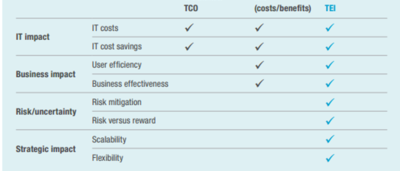Total Economic Impact (TEI)
Developed by Forrester, the Total Economic Impact™ (TEI) methodology provides a rigorous cost and benefit analysis framework that explicitly incorporates an evaluation of future technology and business flexibility and associated risk. As technology platforms increasingly influence the ways in which companies do business, often providing strategic direction and differentiation, it becomes more important than ever to utilize a consistent, repeatable evaluation process to make the best decisions to achieve the desired results.[1]
Total Economic Impact Methodology[2]
Giga has developed an return on investment (ROI)-based methodology for analyzing and evaluating the costs, benefits and risks of IT decisions. This methodology, termed Total Economic Impact™, provides a holistic view of IT decisions by including costs, benefits, flexibility and risk. The TEI methodology, therefore, allows the measurement of the effectiveness of an IT decision or project and can be used as a proactive, predictive tool. Since it includes risk, TEI can also be used with a portfolio analysis methodology to determine the best mix of IT spending that aligns with organizational goals. Unlike a cost or technology-based analysis, TEI does not rely on industry averages or factors applied to all organizations, but is more a methodology for evaluating projects. Additionally, TEI can be used at all stages of the project analysis — to create an initial “back of the envelope” evaluation, or a detailed and documented business case. The structure of both remains the same, and as such, leads to iterative refinement as more or better information becomes available. With TEI, one can produce the justifying analysis to prioritize projects and later prove or disprove their ultimate value.
Elements of TEI
TEI is composed of four main elements with associated tools and methodologies for quantification. The four components of TEI are:
1. Impact on IT or project cost
2. Impact on the business or business benefits
3. Future options created or future flexibility
4. Risk or uncertainty

source: Giga Research
TEI Extends The Concepts Of ROI And TCO
TEI is a comprehensive methodology that balances costs with three other equally significant factors: benefits, flexibility, and risk. While costs and benefits are typical ROI components, the analysis of risk and flexibility gives the TEI study added depth and credibility. Flexibility takes into account the value of future options that investing in a specific technology can provide to an organization. Risk accounts for and quantifies the likelihood that costs may be higher than original estimates and benefits may not reach targeted levels. The incorporation of risk makes the final ROI more realistic and allows for the identification of risk mitigation strategies, such as additional support or training.[3]

source: Forrester
Total Economic Impact Case Studies
- The Total Economic Impact Of Cisco’s Borderless Networks Cisco
- The Total Economic Impact™ Of Microsoft Office 365, Enterprise Customers Microsoft
- The Total Economic Impact™ of Google Apps for Work Google
